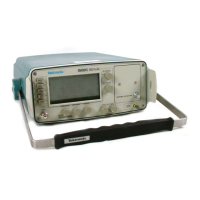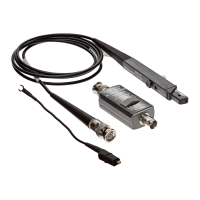Circuit Descriptions
1502C MTDR Service Manual
5–5
A switching pre-regulator reduces this voltage to +15.8 VDC and is used to power
the battery charger. This voltage is also processed through a rectifier and power
switch to power the post-regulator.
If a battery is installed, the battery charger operates as a current source to provide
a constant charging current. Voltage limiting circuits in the charger prevent battery
overcharge by reducing the charge current as the battery voltages approaches +12.5
VDC.
The battery provides a terminal voltage of 10 to 12.5 VDC, with a nominal capacity
of up to 2.0 Amp-Hours. It also is connected through a rectifier to the instrument’s
power switch and post-regulator.
When the power switch is closed, an FET power transistor is momentarily turned
on by the deep discharge protection circuit. If the voltage to the post-regulator rises
to +9.7 VDC or greater, the transistor switch remains on. If at any time, the voltage
drops below +9.7 VDC, the transistor turns off and the power switch must be
recycled to restart the instrument. This operation prevents discharge of the battery
below +10 VDC. Such a discharge could cause a reverse charge in a weak cell,
resulting in permanent cell damage.
The post-regulator is a boost switching regulator that increases its input voltage to
a constant +16.2 VDC output. This voltage is supplied directly to the processor for
large loads, such as the display heater, electroluminescent backlight, and options
port. The post-regulator also supplies a DC-to-DC converter that generates
"
5 VDC and
"
15 VDC for use in the instrument.
Status signals indicating whether the instrument is running on AC line voltage or
the battery, and if the battery is approaching turn-off level, are supplied to the
instrument by the deep-discharge protection circuits.
The AC line power is received by the connector in the EMI filter (FL1). This filter
prevents high frequency signals generated in the instrument from being conducted
back to the AC power line. The line voltage is fused (F101) and switched (S201)
to the primary step-down transformer (T201). Both the switch and the fuse can be
accessed from the outside of the instrument via covers on the rear of the cabinet.
The primary of T201 is wound in two identical sections. These sections are
connected by S201 (in parallel for 110 VAC operation or in series for 220 VAC
operation). The secondary of T201 is connected by a short two-wire cable to the
Power Supply Board. The MOV (R101), across one of T201’s primaries, protects
the power supply if 220 VAC is applied while S2011 is in the 110 VAC position.
Fuse F101 will open in this event.
The secondary voltage is full-wave rectified by CR1010 and filtered by capacitor
C1010. The large value of this capacitor allows it to supply energy to the instrument
between half cycles of the line voltage.
Primary Circuit
Pre-Regulator
Artisan Technology Group - Quality Instrumentation ... Guaranteed | (888) 88-SOURCE | www.artisantg.com

